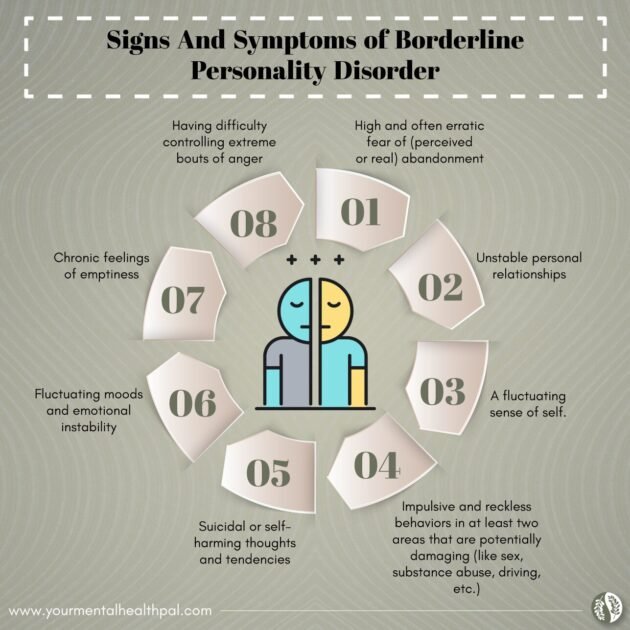Borderline personality disorder (BPD) affects 1.6% of the total American population, as per a 2023 research published in Stat Pearls. Now, while that percentage might seem small or insignificant in the larger scheme of things, it amounts to a large number in a country like America.
This percentage means that around 4 million people in the country suffer from BPD (which is more than the number of people with schizophrenia). And yet, borderline personality disorder is one of the misunderstood and stigmatized mental health conditions.
And it’s not just we who are saying it. Research published in Borderline Personal Disorder and Emotion Dysregulation proved that many healthcare professionals are more hesitant to work with people having BPD than any other mental illness.
Borderline personality disorder is defined as a mental health condition that affects people’s abilities to regulate and manage their emotions. And while that might seem simple on paper, it’s far from the truth. Ask any professional or someone dealing with BPD, and you’ll know how difficult and debilitating the condition truly is.
While we have come a long way in enhancing our understanding of mental health disorders, we are still far behind when it comes to accepting the complexities of BPD. A part of this stems from our lack of understanding of what borderline personality truly is.
In this blog post, we will break down borderline personality disorder and take a deep dive into its symptoms, causes, diagnosis, and treatment options.
But before we get started, here’s something important.
Mental health is diverse and complex. They exist on a spectrum, and every individual has their own experiences. Therefore, don’t start diagnosing yourself with the knowledge you get by reading a few articles on the Internet (though we are incredibly grateful to you for stopping by to enhance your understanding of an important topic). If you find this article helpful or resonate with the symptoms explained in it, consider this as the beginning of your journey of getting the right help.
That’s it. Let’s dive in!
What Is Borderline Personality Disorder?

BPD is one of the types of cluster B personality disorder. This cluster is defined by disorders that affect a person’s relationships and emotions and often lead to behaviors that are erratic and dangerously extreme. Other forms of cluster B personality disorders are anti-social and narcissistic personality disorders.
The characteristics of borderline personality disorder include instability – in terms of self-image, emotions, and relationships. This instability usually emerges due to the constant fear of abandonment. Affected individuals have self-image issues, feelings of emptiness, and an extreme fear of being alone. They experience a higher intensity of emotions and take time to get back to their emotional baseline.
Individuals with borderline personality disorders can often go to alarming lengths to avoid abandonment (even if the fear is just in their minds). They have a higher affinity toward reckless and harmful behaviors like self-harm, substance abuse, and gambling.
BPD usually begins in adolescence, and there’s a gender difference, with around 75% of diagnosed patients being women.
Initially, borderline personality disorder was considered an extremely difficult condition to treat. In fact, in the 1960s-70s, doctors indiscriminately gave a BPD diagnosis to anyone whose condition seemed untreatable. However, with development in the field of medical science, the understanding of BPD transformed into a highly treatable condition.
While there’s still no cure, those who get the right treatment can go into remission or experience reduced symptoms and effectively manage their conditions. In fact, as per research published on Stat Pearls, around 90% of patients went into remission over ten years.
Why Is the Label ‘BPD’ Considered a Problem?
‘Personality disorder’ is a highly debated and controversial term in the mental health community that has been time and again rejected by people (including clinicians and other professionals). Many people confuse personality disorders as personality quirks or flaws, which decreases the severity of the situation and increases stigma and self-loathing among patients.
This means that the term BPD might make individuals affected by the condition see themselves more negatively and make those around them behave similarly. Moreover, doctors might also harbor bias toward people with personality disorders because they are far too commonly perceived as difficult patients.
There are other proposed names for borderline personality disorder:
- emotionally unstable personality disorder (EUPD),
- emotional intensity disorder (EID), and
- borderline pattern personality disorder (borderline pattern PD).
It’s entirely your choice as to which term (if any) you want to use to describe your condition. There’s always going to be a debate about whether a BPD diagnosis is helpful or stigmatizing. Therefore, there are no wrong or even right ways to define your experiences. What’s important is to understand that you deserve love and support.
What Are The Signs And Symptoms Of Borderline Personality Disorder?

As per the Diagnostic and Statistics Manual (DSM-V), here are the nine signs and symptoms of BPD. To get an official diagnosis, an individual must have at least five of these borderline personality disorder symptoms:
- high and often erratic fear of (perceived or real) abandonment,
- unstable personal relationships,
- a fluctuating sense of self and,
- impulsive and reckless behaviors in at least two areas that are potentially damaging (like sex, substance abuse, driving, etc.),
- suicidal or self-harming thoughts and tendencies,
- fluctuating moods and emotional instability,
- chronic feelings of emptiness,
- having difficulty controlling extreme bouts of anger, and
- paranoid and dissociative thoughts attached to stress.
Personality disorders are usually diagnosed at 18 years of age, even if symptoms have persisted before. This is because healthcare professionals need to have a clear pattern of symptoms that have reflected over the years.
If the diagnosis of BPD is given to people younger than 18 years of age, the symptoms should at least be persistently present for a year.

How Common Is BPD?
As mentioned above, BPD affects around 4 million people in America. Out of these, about 75% of those who receive a borderline personality disorder diagnosis are women. Scientists are not sure as to what causes this gender difference. It is believed that women are likely to reach out for help or that there might be a gender bias in diagnosis. Males with similar symptoms are more likely to be misdiagnosed with post-traumatic stress disorder or depression.
Additionally, Mayo Clinic professor Dr. Brian Palmer pointed out that these gender differences usually pan out in clinical studies. Community samples have more even numbers comparatively.
A borderline personality disorder diagnosis is also prevalent common in in-patient psychiatric facilities. Around 20% of patients in these facilities have the condition, as per this research conducted in New York.
However, it’s important to understand that borderline personality is often misdiagnosed as bipolar disorder and vice versa. Therefore, the four million number can be even higher.
How Is A Borderline Personality Disorder Diagnosis Given?
There are no borderline personality disorder tests to diagnose the condition. Therefore, if you are concerned you or your loved ones have any signs of BPD, the first step is to get an appointment with a mental health professional (preferably a psychiatrist or psychologist). Here’s what happens after:
- The doctor will conduct a detailed interview with you to understand your symptoms.
- Your family medical history of mental health issues will be recorded.
- The doctor will refer you to get a physical exam done to rule out any other condition.
- Finally, the DSM-V criteria will be used to diagnose you.
What Are The Causes Of Borderline Personality Disorder?
While there are concrete answers to this question, researchers conclude that a combination of genetic and environmental factors might contribute to the development of BPD.
Therefore, the following factors are considered as contributing causes of borderline personality disorder:
- genetic and biological factors,
- cultural, social, and environmental factors like a person’s childhood, their experiences with family, etc., and
- psychological factors, including a person’s temperament, personality, and resilience toward stress.
Multiple people with BPD report having had adverse childhood experiences or traumatic life experiences early on in their lives. However, a single factor is not responsible for BPD, and it’s more likely a complex interplay of all three factors.
What Are The Types of Borderline Personality Disorders?

A section of medical experts have proposed that there are three types of borderline personality disorders. However, there’s no conclusive evidence about what these types are.
For instance, as per a study by Maaike L. Smits and team, these are the three types of BPD:
- Core BPD – with emotional regulation difficulties and fluctuating sense of self.
- Extravert BPD – with narcissistic and anti-social symptoms.
- Paranoid BPD – with symptoms of schizoid disorder.
Other studies list the types of BPD as:
- affect dysregulation (BPD co-occurring with anxiety disorders),
- rejection sensitivity, and
- mentalization failure.
What Are The Treatments For BPD?
BPD is a highly treatable condition. Treatment is directed toward helping individuals curb dangerous behaviors. The key to the right treatment for BPD starts with finding a healthcare professional who specializes in treating the condition.
Here’s what the usual line of treatment for borderline personality disorder looks like:
1. Psychotherapy
A therapist specializing in personality disorder treats patients with BPD through long-term psychotherapy talk sessions. The following forms of psychotherapy are essential for patients with BPD:
- dialectical-behavioral therapy,
- mentalization-based therapy,
- cognitive-behavioral therapy,
- psychodynamic therapy, and
- group therapy.
2. Medication
While there are no specific medications to treat BPD, anti-depressants and mood stabilizers might help people manage their symptoms.
3. Hospitalization
During a crisis, a hospital visit can help patients receive the required care and support. While most visits are short-term, they usually depend on the patient’s requirements. Hospitalization is preferred if you believe you might harm yourself or those around you.
Conclusion:
Borderline personality disorder is a complex and often misunderstood disorder. It affects people’s emotional regulation abilities, sense of self, and personal relationships.
If you or someone you love has been dealing with the condition, here are a few organizations that provide help for borderline personality disorder:
BPD is often surrounded by myths. Here’s a complete myths vs. facts breakdown about the condition.
To continue learning about mental health daily, subscribe to Your Mental Health Pal.

